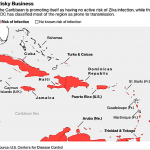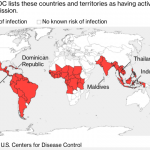Caribbean says Zika no longer an issue. Doctors say not so fast [Cayman Islands listed as risk free]

By Nikki Ekstein From Bloomberg
The truth is complicated.
On Oct. 18, the Caribbean Public Health Agency was celebrating and promoting good news: the World Health Organization (WHO) was no longer classifying its islands as having active virus transmission. Anguilla blasted a press release to travel professionals, with a subject line proclaiming: “Anguilla Removed from List of Countries With Active Zika Transmission.” It may as well have been an excuse for a new regional holiday.
Here’s what actually happened that day: Instead of changing the status of any country on its Zika watch map, the WHO discarded its classification system entirely, a move that signified that the virus had shifted from epidemic to long-term management mode.
Hopeful babymooners and optimistic hoteliers may be cheering the news, but among the scientific community, a different reality is emerging. Zika’s traceability—not the status of the disease itself—is what has changed.
Where In The World Is Zika?
The CDC lists these countries and territories as having active Zika transmission.
See attachment
Source: U.S. Centers for Disease Control
Here’s the good news. Zika outbreaks have declined significantly; as of Oct. 3, just 46 travelers had returned to the continental U.S. with a diagnosis this year, according to the Centers for Disease Control and Prevention (CDC). Last year that number was 437; in 2016, it was 4,897. And for most travelers, “the consequences of Zika tend to be mild to none,” said Dr. Daniel Caplivski, director of the travel medicine program and professor of infectious diseases at Mount Sinai’s Icahn School of Medicine.
But for pregnant women and couples planning to conceive, the risk of Zika may be steeper than previously understood.
In a Morbidity & Mortality Weekly Report that the CDC published in August 2018, the agency revealed that pregnant women infected with Zika have a 1 in 7 chance of delivering a baby with neurological abnormalities or birth defects. “That’s really worthy of our attention,” said Dr. Caplivski, who called the numbers “incredibly significant.”
This, combined with the difficulty in diagnosing Zika, explains why the CDC is staying firm with its broad-sweeping Zika travel advisory, which covers not just the Caribbean but many other parts of the globe.
Here are the latest developments and what they mean for your travel plans.
Is the Caribbean Zika-Free?
No.
What the WHO discarded on Oct. 18 was its classification system for Zika infections, citing a slowdown of transmission reports. According to a WHO spokesperson, the classification system was no longer effective since it has become “increasingly challenging to assess if transmission of the virus has been interrupted in a population.” The spokesperson cites a number of reasons: a high proportion of asymptomatic persons among those infected with Zika virus, lack of specificity of the clinical presentation among cases, complexities of diagnosing, and high movement of people across borders.
Risky Business
The Caribbean is promoting itself as having no active risk of Zika infection, while the CDC has classified most of the region as prone to transmission.
See attachment
Source: U.S. Centers for Disease Control
Because of these factors that complicate diagnosis—and the fact that most people with Zika virus never see a doctor for it—“many countries have stopped detecting Zika virus,” said the spokesperson. “However, this is not enough information to guarantee that circulation of the virus has been completely interrupted.” Put simply: Just because it’s difficult to detect doesn’t mean it’s not there.
Why Is There a Discrepancy Between the WHO and the CDC?
Dr. Caplivski explains that the missions of WHO and CDC overlap, but differ in key ways. WHO is concerned with how viruses and epidemics affect a local population; the CDC considers how people visiting those local communities might be affected by endemic viruses and epidemics.
“As travelers, we are more susceptible to diseases like Zika if we don’t have that kind of herd immunity,” he said. “Eventually we’ll go back to baseline risk, but we’re not there yet.”
WHO seems to agree. It’s currently working with the European Centre for Disease Prevention and Control on a new classification system to assess the risk for Zika virus transmission, indicating that the risks may have evolved but they haven’t disappeared.
A spokesperson for the CDC said that the move by WHO to eliminate its categorization system “is in line with Zika virus infection moving from an emergency response to a sustained longer-term program of work similar to other diseases.” But she added that the agency has “not modified advice for travelers at this time.”
How Serious Is the Risk?
Depends on who you ask. And who you are.
Dr. C. James Hospedales, executive director of the Caribbean Public Health Agency (CARPHA), which obviously has a vested interest in minimizing travelers’ concerns, said in a statement: “The Caribbean is the most tourism-dependent region in the world. It is also one of the most popular honeymoon destinations worldwide and ongoing cancellations due to the [Zika] classification is hurting the industry unnecessarily.”
Donna Banks, chairperson of the Anguilla Tourist Board, agrees. She told Bloomberg that “data submitted by CARPHA gave evidence that there has been no confirmed case of Zika virus transmission in the Caribbean for over 12 months, nor has the virus been detected in travelers returning from the Caribbean to the United Kingdom, Canada, or the United States for over twelve months.”
Data gathered by the European CDC contradicts this claim and shows that Zika was in active transmission throughout most of the Caribbean, including Anguilla, from October to December of 2017, the most recent window available. When asked about the discrepancy, Banks insisted that the country’s ministry of health recorded its last confirmed case in February. (CARPHA did not respond to requests for comment.)
For its part, the CDC has reduced the suggested “wait time” for hopeful fathers exposed to Zika from six months to three—a hopeful move. (Women are believed to pass the virus faster, in just two months.) But the overarching message is still clear: If you’re planning to expand your family in the very near future, don’t mix Zika exposure with procreation.
“A lot of this gets into advising people about worst-case scenarios, even if they are rare events,” said Dr. Caplivski. “We’re talking about outcomes as severe as microcephaly and developmental defects—risks that for most of the population are entirely avoidable.”
Curious what everyday practitioners were advising on the heels of WHO’s new messaging, I called my own OB-GYN, Dr. Jennifer Butt, who owns a small private practice on Manhattan’s Upper East Side. “It’s too premature for me to change my recommendations,” she told me, citing that no reputable group—not the Academy of Obstetricians and Gynecologists, not the Society for Maternal and Fetal Medicine, nor the CDC—has changed its stance on Zika.
“The WHO is saying that the disease is less traceable, not that it’s any less of a threat,” she explained. “I would be very hesitant to jump the gun.”
Where Can I Travel Without Worrying About Zika This Winter?
So where does that leave the sun-seeking pregnant, hoping-to-get-pregnant, and responsible dads-to-be among us? The CDC’s travel warnings for Zika cover a surprising swath of the globe, extending from Southeast Asia (including Indonesia, Thailand, and the Maldives) to central and east Africa to South America and the South Pacific. (Yes, the Duchess of Sussex is taking some risks.)
But within the Caribbean, some risk-free spots do exist: The Bahamas, the Cayman Islands, Guadeloupe, Martinique, and St. Barts have all been cleared by the CDC. In Latin America, high-altitude capitals such as Mexico City and Bogota are safe to explore even if beach-resort Mexico and Colombia are on the no-go list; the entire European continent is blissfully Zika-free. (That includes the now-trendy Azores, plus the islands off Spain, Italy, and Greece.)
As Dr. Caplivski pointed out, “We ask women to do so many things differently during pregnancy to mitigate risk.” Sticking to a shorter list of vacation spots might be one of the easiest.
IMAGES:
A beach in Grand Cayman, another destination cleared for babymoons by the CDC.Photographer: Michal Ben Ari/ EyeEm/Getty Images
Gustavia, the main town in St. Barts—an island that has been removed from the CDC’s travel advisory. Photographer: Holger Leue / LOOK-foto/Getty Images
Anguilla remains on the CDC’s travel advisory for active Zika transmission. Photographer: Patrice Hauser/Getty Images
An Aedes aegypti mosquito, the culprit for Zika transmission in the Caribbean and beyond.Photographer: Science Source/Getty Images
For more on this story go to: https://www.bloomberg.com/news/articles/2018-11-01/does-the-caribbean-still-have-zika-virus-who-cdc-travel-warning










